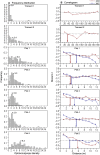Graveyards on the move: the spatio-temporal distribution of dead ophiocordyceps-infected ants
- PMID: 19279680
- PMCID: PMC2652714
- DOI: 10.1371/journal.pone.0004835
Graveyards on the move: the spatio-temporal distribution of dead ophiocordyceps-infected ants
Abstract
Parasites are likely to play an important role in structuring host populations. Many adaptively manipulate host behaviour, so that the extended phenotypes of these parasites and their distributions in space and time are potentially important ecological variables. The fungus Ophiocordyceps unilateralis, which is pan-tropical in distribution, causes infected worker ants to leave their nest and die under leaves in the understory of tropical rainforests. Working in a forest dynamic plot in Southern Thailand we mapped the occurrence of these dead ants by examining every leaf in 1,360 m(2) of primary rainforest. We established that high density aggregations exist (up to 26 dead ants/m(2)), which we coined graveyards. We further established that graveyards are patchily distributed in a landscape with no or very few O. unilateralis-killed ants. At some, but not all, spatial scales of analysis the density of dead ants correlated with temperature, humidity and vegetation cover. Remarkably, having found 2243 dead ants inside graveyards we only found 2 live ants of the principal host, ant Camponotus leonardi, suggesting that foraging host ants actively avoid graveyards. We discovered that the principal host ant builds nests in high canopy and its trails only occasionally descend to the forest floor where infection occurs. We advance the hypothesis that rare descents may be a function of limited canopy access to tree crowns and that resource profitability of such trees is potentially traded off against the risk of losing workers due to infection when forest floor trails are the only access routes. Our work underscores the need for an integrative approach that recognises multiple facets of parasitism, such as their extended phenotypes.
Conflict of interest statement
Figures





References
-
- Woolhouse M, Donaldson A. Managing foot-and-mouth - The science of controlling disease outbreaks. Nature. 2001;410:515–516. - PubMed
-
- Moore J. Parasites and the behavior of animals. Oxford University Press; 2002.
-
- Dawkins R. The extended phenotype. Oxford University Press; 1982.
-
- Maeyama T, Terayama M, Matsumoto T. The abnormal-behavior of Colobopsis sp (Hymenoptera, Formicidae) parasitized by Mermis (nematoda) in Papua-New-Guinea. Sociobiology. 1994;24:115–119.
MeSH terms
LinkOut - more resources
Full Text Sources

